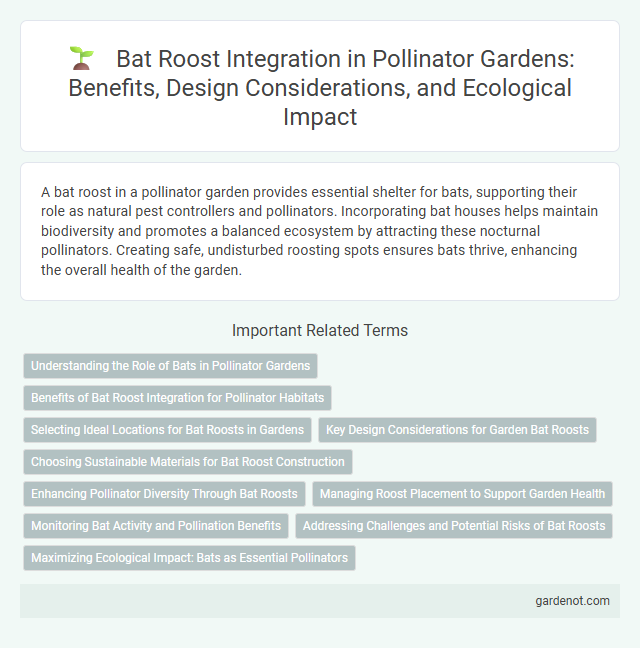A bat roost in a pollinator garden provides essential shelter for bats, supporting their role as natural pest controllers and pollinators. Incorporating bat houses helps maintain biodiversity and promotes a balanced ecosystem by attracting these nocturnal pollinators. Creating safe, undisturbed roosting spots ensures bats thrive, enhancing the overall health of the garden.
Understanding the Role of Bats in Pollinator Gardens
Bats serve as vital nocturnal pollinators in pollinator gardens, facilitating the reproduction of night-blooming plants such as agave and cacti through their feeding activities. Establishing bat roosts within the garden supports bat populations by providing shelter, which enhances their pollination efficiency and contributes to biodiversity. Recognizing the ecological role of bats promotes the integration of bat-friendly habitat features, improving overall garden health and resilience.
Benefits of Bat Roost Integration for Pollinator Habitats
Integrating bat roosts into pollinator gardens enhances biodiversity by providing shelter for bats, which are effective nocturnal pollinators and natural pest controllers. Bats contribute to the pollination of various night-blooming plants, increasing the garden's ecological balance and plant reproduction rates. Their presence reduces the need for chemical pesticides, promoting a healthier environment for both pollinators and surrounding wildlife.
Selecting Ideal Locations for Bat Roosts in Gardens
Choosing ideal locations for bat roosts in pollinator gardens involves identifying quiet, sheltered spots with minimal human disturbance to encourage bat habitation. Locations near water sources like ponds or streams increase insect availability, enhancing bats' feeding efficiency. Elevated sites such as tree hollows, bat boxes, or under eaves provide safe resting places critical for supporting local bat populations and promoting garden biodiversity.
Key Design Considerations for Garden Bat Roosts
Creating an effective bat roost in a pollinator garden requires attention to temperature regulation, ensuring the structure provides a warm, dry environment between 80-100degF suitable for bat habitation. The roost design should include narrow crevices or chambers at least 3/4 inch wide to accommodate bats' need for tight spaces while allowing proper air circulation. Positioning the roost in a location with minimal disturbance, such as facing south or southeast to maximize morning sunlight, enhances bat occupancy and supports local pollination efforts.
Choosing Sustainable Materials for Bat Roost Construction
Selecting sustainable materials like reclaimed wood, bamboo, and untreated natural fibers for bat roost construction supports environmental conservation and enhances habitat durability. Using non-toxic, weather-resistant materials ensures bats are protected from harmful chemicals and extreme weather conditions. Incorporating sustainably sourced resources reduces ecological impact while promoting biodiversity within the pollinator garden ecosystem.
Enhancing Pollinator Diversity Through Bat Roosts
Bat roosts play a critical role in enhancing pollinator diversity by providing essential habitats for nectar-feeding bats, which are key pollinators for various native plants. These nocturnal pollinators contribute to the reproduction of night-blooming flowers and help maintain ecosystem balance by supporting plant species that other pollinators do not frequent. Integrating bat roosts into pollinator gardens fosters a broader range of pollination activities, boosting biodiversity and promoting resilient native plant communities.
Managing Roost Placement to Support Garden Health
Strategic placement of bat roosts in pollinator gardens enhances natural pest control by attracting insect-eating bats, which reduces the need for chemical pesticides. Positioning roosts near flowering plants and water sources creates an optimal habitat that supports both pollinators and bats, promoting biodiversity. Regular maintenance of roost structures prevents disease and ensures long-term garden health by maintaining a stable bat population.
Monitoring Bat Activity and Pollination Benefits
Monitoring bat activity in a pollinator garden involves using ultrasonic detectors and infrared cameras to track bat movements and foraging behavior. Studies show that bats contribute significantly to pollination by transferring pollen among night-blooming flowers, enhancing plant reproduction and biodiversity. Regular monitoring helps assess bat population health and the effectiveness of the garden in supporting these crucial nocturnal pollinators.
Addressing Challenges and Potential Risks of Bat Roosts
Bat roosts in pollinator gardens play a crucial role in supporting local ecosystems by providing shelter for pollinating bats, which enhance plant reproduction. Challenges include managing disease risk, particularly from histoplasmosis, and preventing disturbance from human activity that can cause bat abandonment. Implementing proper bat-friendly structures and maintaining safe distances from high-traffic areas mitigate potential risks while maximizing pollination benefits.
Maximizing Ecological Impact: Bats as Essential Pollinators
Bat roosts play a crucial role in pollinator gardens by providing shelter to bats, which are essential pollinators for many nocturnal and night-blooming plants. These mammals contribute significantly to the pollination of species such as agave, durian, and certain cacti, supporting biodiversity and ecosystem health. Maximizing ecological impact involves creating and preserving bat-friendly habitats that enhance pollination efficiency and promote sustainable plant reproduction.
Bat roost Infographic

 gardenot.com
gardenot.com